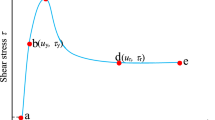Abstract
A damage strain softening model for predicting the shear behavior of soil–structure interfaces is presented. The damage model, which contains only four parameters (i.e., undamaged shear modulus G′, damage evolution parameters n and m, and the residual shear stress τ r), is developed based on Weibull distribution statistical damage theory. By fitting curves, the model parameters are obtained from director simple shear tests. As the shear thickness is usually considered an important factor on soil–structure interface constitutive relations, the shear thickness ratio (η) is introduced to the model to compensate for the influence of the shear thickness. The relationships between the model parameters and the shear thickness ratio η are also analyzed under different levels of normal stress based on data from both direct and simple shear tests. The results show that the undamaged shear modulus G′ increases with increasing normal stress and increasing shear thickness. The shear thickness has a significant effect on the damage evolution parameter n, but the normal stress does not. Neither normal stress nor shear thickness have significant effects on the damage evolution parameter m. The residual shear stress τ r increases with increasing normal stress.
Similar content being viewed by others
References
Boulon, M. (2003). “A strain-hardening elastoplasticc model for sandstructure interface under monotonic and cyclic loading.” Mathematical and Computer Modeling, Vol. 37, pp. 623–630. DOI: 10.1016/ S0895-7177(03)00056-6.
Cao, W. G., Fang, Z. L., and Tang, X. J. (1998). “A study of statistical constitutive model for soft and damage rocks.” Chinese Journal of Rock Mechanics and Engineering, Vol. 17, No. 6, pp. 628–633 (In Chinese).
Desai, C. S. and Ma, Y. Z. (1992). “Modeling of joints and interfaces using the disturbed-state concept.” International Journal for Numerical and Analytical Methods in Geomechanics, Vol.16, No. 9, pp. 623–653, DOI: 10.1002/nag.1610160903.
Desai, C. S. and Zaman, M. M. (1984). “Thin layer element for interfaces and joints.” International Journal for Numerical and Analytical Methods in Geomechanics, Vol. 8, No. 1, pp.19–43, DOI: 10.1002/ nag.1610080103.
Duncan, J. M. and Chang, C. Y. (1970). “Nonlinear analysis of stress and strain in soils.” ASCE Journal of the Soils Mechanics and foundation Division, Vol. 96, No. 5, pp.1629–1653.
Evgin, E. and Fakharian, K. (1996). “Effect of stress paths on the behavior of sand-steel interfaces.” Canadian Geotechnical Journal, Vol.33, No. 6, pp. 485–493, DOI: 10.1139/t96-116-336.
Gens, A., Carol, I., and Alonso, E. E. (1990). “Constitutive model for rock joints formulation and numerical implementation.” Computers and Geotechnics, Vol. 9, No. 2, pp. 3–20, DOI: 10.1016/0266-352X(90)90026-R.
Gómez, J. E., Filz, G. M., and Ebeling, R. M. (2003). “Extended hyperbolic model for sand-to-concrete interfaces.” Journal of Geotechnical and Geoenvironmental Engineering, Vol. 129, No. 11, pp. 993–1000, DOI: 10.1061/(ASCE)1090-0241(2003)129:11(993).
Hu, L. M. (2003). “Application of damage model for soil-structure interface.” Computers and Geotechnics, Vol. 30, pp. 165–183, DOI: 10.1016/S0266-352X(02)00059-9.
Hu, L. M. and Pu, J. L. (2001). “Experimental study on mechanical characteristics of soil-structure interface.” Chinese Journal of geotechnical Engineering, Vol. 23, No. 4, pp. 431–435 (In Chinese).
Krajcinovic, D. and Silva, M. A. G. (1982). “Statistical aspects of the continuous damage theory.” International Journal of Solids Structures, Vol. 18, No. 7, pp. 551–562, DOI: 10.1016/0020-7683(82)90039-7.
Lemaitre, J. (1984). “How to use damage mechanics.” Nuclear Engineering and Design, Vol. 80, No. 2, pp. 233–245, DOI: 10.1016/0029-5493(84)90169-9.
Luo, T., Yao, Y. P., and Matsuoka, H. (2000). “Soil strength equation in plane strain based on SMP.” Rock and soil Mechanics, Vol. 21, No. 4, pp. 390–393 (In Chinese).
Matsuoka, H. and Nakai, T. (1974). “Stress-deformation and strength characteristics of soil under three difference principal stresses.” Proceedings of Japan Society of Civil Engineers, No. 232, pp. 59–70, DOI: 10.2208/jscej1969.1974.232_59.
Milad, T., Reza, M., and Hasan, T. (2014). “An investigation on the mechanical properties of granular materials in interface with asphaltic concrete.” Construction and Building Materials, Vol. 62, pp. 85–95, DOI: 10.1016/j.conbuildmat.2014.03.016.
Pradhan, S. K. and Desai, C. S. (2006). “DSC model for soil and interface including liquefaction and prediction of centrifuge test.” Journal of Geotechnical and Geoenvironmental Engineering, Vol. 132, No. 2, pp. 214–222, DOI: 10.1061/(ASCE)1090-0241(2006) 132:2(214).
Roscoe, K. H., Schofield, A. N., and Thurairajah, A. (1963). “Yielding of Clays in state wetter than Critical.” Geotechnique, No. 13, pp. 211–240, DOI: 10.1680/geot.1963.13.3.211.
Roscoe, K. H. and Burland, J. B. (1968). “On the generalized stressstrain behavior of an ideal wet clay.” In: Heyman J, Leckie F A. Engineering Plasitcity[C], Cambridge; Cambridge University Press, pp. 535–609.
Sharma, J. S., Fleming, I. R., and Jogi, M. B. (2007). “Measurement of unsaturated soil–geomembrane interface shear-strength parameters.” Canada Geotechnical Journal, Vol. 44, No. 1, pp. 78–88, DOI: 10.1139/T06-097.
Sun, J. Z. and Shi, G. L. (2007). “Bounding surface model for soilstructure interface under cyclic loading.” Rock and Soil Mechanics, Vol. 28, No. 2, pp. 311–314 (In Chinese).
Wu, Y. L., Li, D. H., and Xu, G. L. (2014). “Research on the damage interface constitutive model.” Chinese Journal of Yellow River, Vol. 36, No. 3, pp. 80–83, DOI: 10.3969/j.issn.1000-1379.2014.03.026.
Xia, H. C., Zhou, G. Q., and Shang, X. Y. (2007). “Statistical damage softening constitutive model of soil-structure interface based on weibull random distribution.” Journal of China University of Mining and Technology, Vol. 36, No. 6, pp.734–738 (In Chinese).
Yin, Z. Z. and Zhu, H. (1994). “Numerical simulation of the deformation in the interface between soil and structural material.” Chinese Journal of Geotechnical Engineering, Vol. 16, No. 3, pp. 14–22 (In Chinese).
Zhang, G. and Zhang, J. M. (2008). “Unified modeling of monotonic and cyclic behavior of interface between structure and gravelly soil.” Soils and Foundations, Vol. 48, No. 2, pp. 231–245, DOI: 10.3208/ sandf.48.231.
Author information
Authors and Affiliations
Corresponding author
Rights and permissions
About this article
Cite this article
Long, Y., Chen, Jh. & Zhang, Js. Introduction and analysis of a strain-softening damage model for soil–structure interfaces considering shear thickness. KSCE J Civ Eng 21, 2634–2640 (2017). https://doi.org/10.1007/s12205-017-0476-2
Received:
Revised:
Accepted:
Published:
Issue Date:
DOI: https://doi.org/10.1007/s12205-017-0476-2




